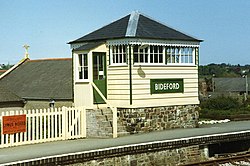This article needs additional citations for verification .(October 2009) |
| Bideford Railway Heritage Centre | |
|---|---|
 A replica of the original signal box at Bideford Railway Station | |
| Commercial operations | |
| Built by | London and South Western Railway |
| Original gauge | 4 ft 8+1⁄2 in (1,435 mm) standard gauge |
| Preserved operations | |
| Stations | 1 |
| Preserved gauge | 4 ft 8+1⁄2 in (1,435 mm) standard gauge |
| Commercial history | |
| Opened | 2 November 1855 |
| Closed | 6 November 1982 |
| Preservation history | |
| 1988 | Society formed |
| Headquarters | Bideford, Devon |
| Website | |
| www | |
The Bideford Railway Heritage Centre CIC (previously the Bideford and Instow Railway Group) in Devon, England is a community interest company that is responsible for the management of the site of Bideford railway station. The company is also responsible for Instow signal box which opens on occasional Sundays and bank holidays from Easter to October. [1]
